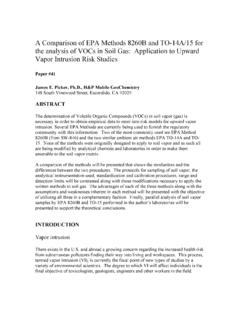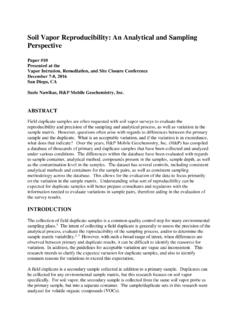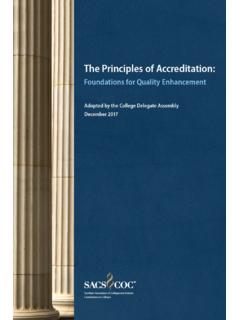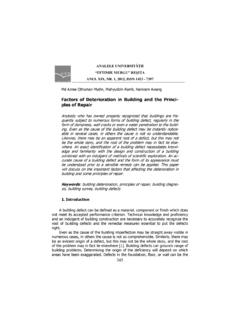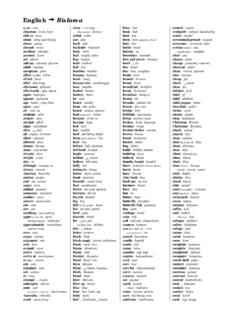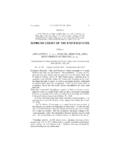Transcription of Investigation and Remediation A Layman’s Guide to the New ...
1 Since the promulgation ofUpdate III of EPA s SW-846,Test Methods for Evaluating SolidWaste, Physical/Chemical Methods, thedocument s new methods for volatileorganic compound (VOC) analysishave created apparent confusionthroughout much of the environ-mental community. In response tothis confusion, EPA released a memoon August 7 to clarify some of theissues. In this article, we ll addresssome of the key issues of concernand conclude with recommendationsto help you to decide which proto-cols to follow or understand the pros and consof the new VOC methods, let s re-view the most salient changes in thenew update. Changes in AnalyticalMethodsIn Update III, several obsoletepacked-column gas chromatographic(GC) methods have been deleted andreplaced with capillary GC , analytical methods 8010(halogenated hydrocarbons by GC),8020 (aromatic hydrocarbons byGC), and 8240 (VOCs by GC/MassSpectrometry (MS)) have been de-leted.
2 They have been replaced bymethods 8021 (halogenated and aro-matic hydrocarbons by GC) and 8260(VOCs by GC/MS). The eliminationof these analytical methods does notcreate significant changes in thequality or type of data received fromlaboratories, because most laborato-ries have been using the capillarymethods for several years. There are, however, two signifi-cant factors that you should be awareof in the new analytical methods: Soil values are reported on a dry-weight basis. Calibrations must be performedfor every 10 samples rather thanfor every 20 first factor should not beoverlooked by regulators, because, insome states, soil values are custom-arily reported on a wet-weight on the water content of asample, use of dry versus wet weightcould change reported values by afactor of 2. As a result, we recom-mended that you ask your laboratoryto state clearly in its reportingwhether the results represent dry-weight or wet-weight values.
3 Changes in SamplePreparation MethodsPrior to Update III, there were essen-tially three methods for preparingsolid samples for volatile analysis: Solvent extraction and directinjection (typically done as amicroextraction of soils or concen-trated wastes in a VOA vial withmethanol) for high-concentrationsamples; Direct purge-and-trap preparation(EPA method 5030) for soils withlow concentrations; and Methanol extraction, dilution intowater, and purge-and-trap (alsoby EPA method 5030) for medium-to high-concentration purge-and-trap preparationmethods offered much lower detec-tion levels than the direct-injectionmethod and were more commonlyused for VOC analysis that requiredlow (<50 g/kg) detection limits. Forsoils, samples were either mixedwith water and added directly to thepurge-and-trap device (direct soilsparging for low-concentration sam-ples), or, for higher-concentrationsamples, they were extracted withmethanol, and an aliquot of themethanol (typically 10 L to 100 L)was added to the III includes seven sam-ple preparation procedures: extraction and analysis (method 5021) preparation (EPAmethod 5030B) for soil purge-and-trap forsoils (method 5035) dilution-direct injec-tion for VOCs in waste oilIt is important to realize thatVOC results can vary, depending onthe preparatory method used ( ,high-concentration methods may notwork for low-concentration samples,and vice versa).
4 Because there arenow seven different preparatorymethods, it is much more importantthat the end users of the VOC dataunderstand which method was usedto prepare individual samples andwhich method applies to which typeof sample and Overview of the SamplePreparation MethodsLet s briefly review these samplingmethods. Because methods 5, 6, and7 are not commonly used, we willnot discuss them in this overview. 1. Solvent extraction and directinjection. This method isextremely reliable and allows thereanalysis of the extract as manytimes as possible. For fuel-related aromatic compounds( , BTEX, naphthalene, tri-methylbenzenes) and MTBE,detection levels of 25 g/kg to 50 g/kg can be obtained. Thismethod is the best to use forhigher-concentration samples(greater than 200 g/kg),because there is little potentialfor carryover between Headspace analysis bymethod 5021.
5 Prior to UpdateIII, EPA considered this methodto be useful for screening pur-poses only, primarily because ofthe limitations of availableequipment. However, because itis a relatively easy and fastmethod, many laboratories, par-ticularly mobile laboratories,have used it for many days, reliable data arereadily achievable with auto-mated instruments, especiallyfor compounds with relativelyhigh Henry s law constants, pro-21 LUSTLine Bulletin 30A layman s Guide to the New EPA Methods for VOC Analysisby Blayne Hartman and Rob HitzigInvestigation and Remediationncontinued on page 2222 LUSTLine Bulletin 30vided the headspace conditionsare kept constant ( , amountof sample, time of heating, tem-perature of heating). This is par-ticularly true for fuel-relatedsites data for aromatic hydro-carbons generated by thismethod should be fine. How-ever, this method is not suitablefor MTBE or ethylene dibromide(EDB) because both have lowHenry s law constants.
6 It is nec-essary to collect more than onesample for reanalysis in theevent that VOC concentrationsexceed the instrument s calibra-tion Purge-and-trap by method5030B. This method is the sameone used in earlier versions ofSW-846, except for one key dif-ference: It no longer allows thesoil itself to be added directly tothe purge-and-trap device(direct-soil sparging). To analyzesoils by this method, the soilmust be methanol-extracted; analiquot of the extract is thenadded to the purge-and-trapdevice. This approach allows fordetection levels in the lowmicrogram/kilogram range (<10 g/kg) for most fuel-relatedhydrocarbons and slightlyhigher levels (25 g/kg to 50 g/kg) for some Closed system purge-and-trap by method 5035. Thismethod is designed to minimizethe loss of VOCs from soil. Soilsamples are sealed in a gas-tightvial in the field and then ana-lyzed without ever opening thevial.
7 This method has an advan-tage over methanol preservationin that it allows for extremelylow detection limits (<1 g/kg)for all VOCs (including halo-genated solvents); however,VOC concentrations exceeding 100 g/kg to 200 g/kg exceedthe instrument s working range,depending on the VOC concentrations thislow are difficult to estimate priorto analysis, and the sample canbe analyzed only once, it is neces-sary to collect more than onesample for reanalysis in the eventthat concentrations are in Soil SampleCollection, Preservation, andStorageThe most significant change in thenew update is the addition of proto-cols that describe field preservationand storage of soil samples for VOCanalysis. The purpose of these proto-cols is to provide for minimal loss ofvolatiles from samples caused byboth volatilization and biodegrada-tion from the time of collection to thetime of analysis.
8 The most effectiveway to do this is to preserve or ana-lyze samples shortly after they havebeen sample preservation proto-cols have introduced considerableconfusion, because they differ foreach preparation method and, insome instances, are contradictorywithin the same method. For exam-ple, method 5021 (headspace)describes on-site sample preserva-tion using phosphoric acid; however,the method also allows for off-sitepreservation in the laboratory which, in effect, defeats the purposeof the new protocols. As another example, method5035 (closed-system purge-and-trap)offers four on-site handling optionsfrom which the field sampler canchoose. One of these options calls forthe use of bisulfate solution as apreservative, a second optioninvolves on-site methanol extraction,a third option is to collect the samplein a headspace-free, gas-tight sam-pler ( , EnCore), and a fourthoption allows for off-site samplepreparation.
9 Which method 5035 option youchoose depends on a multitude offactors, including the concentrationof VOCs in the soil (which you don tknow at the time of field collection),the type of soil ( , percent carbon-ate), the method the lab uses, andwhether you are shipping the do all these options do forfield sampling personnel? They cre-ate confusion and add an extra bur-den to their already demanding listof tasks. The consequence: an in-creased potential for errors in VOCdata because of the variations in howsamples are handled in the to Do?The introduction to the new EPAmethods, which was restated in theAugust 7 memo, clearly states thatthe SW-846 methods are meant to beguidance only, not encourages local agencies toadopt sampling methods that theyfeel are most applicable to their spe-cific problems and needs. EPAencourages agencies to provide forperformance-based flexibility andmodifications that will meet the spe-cific requirements of a project.
10 Sowhat protocols should you follow toensure the most representative data?First, let s begin with the pre-sumption that most of the confusingissues and potential problems will becircumvented if samples are analyzedon-site. Because on-site analysisallows samples to be analyzed withinhours rather than days, acid andmethanol preservation should not benecessary. Mobile laboratories thatare capable of conducting SW-846-quality analyses are available in mostlocations throughout the s Office of UndergroundStorage Tanks (OUST) has encour-aged the use of field analytical meth-ods for many years because of theadvantages gained by having on-sitedata to make real-time decisions.(For more information on the use offield analysis in conducting siteassessments, check out Expedited SiteAssessment Tools For UndergroundStorage Tank Sites EPA 510-B-97-001.)As an alternative to on-siteanalysis, on-site methanol and/oron-site water preservation offer themost advantages, depending on theVOCs you are measuring.
